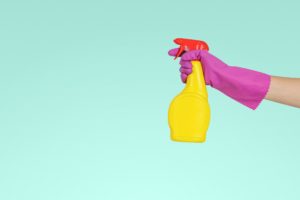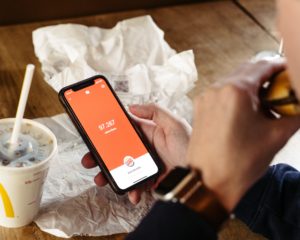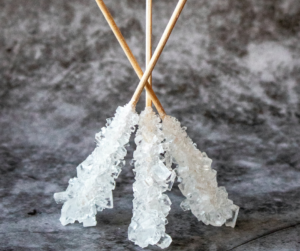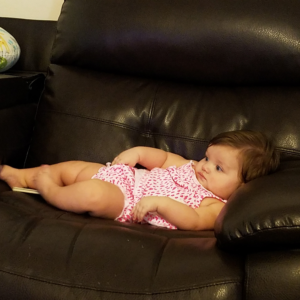Kids and adults never let go of their cell phones. We use our phones anywhere and everywhere: in a car, in school, in hospitals, in a restaurant, and even in the bathroom. While we tend to wash our hands regularly, the same is not always true for cleaning our phones.
You can’t just throw it in the wash or run it through the dishwasher, and it’s not always obvious how to clean them. Phones should be cleaned often so they don’t become a source of illness. So how do you keep the army of germs from traveling from your child’s phone to their face when they bring their phone to their ear?
According to a study by the National Institute of Health, mobile phones have already been shown to be frequently contaminated with potential pathogens.
There are several good ways to clean a phone that has fallen victim to the porcelain throne or even ones that have just been in the hands of kids.
Cleaning Solutions
Cleaning solutions are probably the most common way to clean phones and other electronics. In general, you don’t want to use any kind of disinfecting agent on your phone. Those may void the warranty on your phone. It is important to be respectful of the manufacturer’s recommendations.
Household Solutions
Several household solutions are effective in cleaning and sanitizing phones and other electronics. The most common approach is to use a combination of distilled water and isopropyl alcohol. You should use a solution of half distilled water and half isopropyl alcohol with a microfiber cloth for best results.
Subscribe to my free newsletter and download 7 Steps for a Germ-Free Cell Phone
There are several cleaners to NEVER use to clean a cell phone or any electronics. They are:
- Bleach
- Hydrogen peroxide
- Window or household cleaners
- Compressed air
- Aerosol spray cleaners
- Harsh solvents like acetone or benzene
- Ammonia
- Abrasive powders
The most important thing to remember when cleaning electronics is to avoid any excess moisture. Moisture can damage the interior of your electronic devices and render them useless. Use extra caution when cleaning your cell phone screens as many screens have a coating that repels oils from hands and fingers. The effectiveness of this coating will lessen over time but you can keep it safe longer by never using anything abrasive to clean the screen.
Store-Bought Solutions
There are many cleaning solutions that you can purchase to clean your cell phone. The most popular are iKlenz and eScreen. These are simply a combination of isopropyl alcohol and distilled water that you can make at home for a lot less money. Many of the companies that sell electronic cleaning solutions also have wipes. I have personally found these very helpful. Wipes can be used on the go. Throw a few in their backpack and remind your kids to use them.
Cleaning Devices- UV Cleaners and Ozonators
There are two main types of UV phone cleaners: closed gadgets with a lid and portable sanitizing wands. You can also find ozonators being sold to clean phones.
Closed UV Cleaner
A closed UV phone cleaner starts working either automatically or after you press a button that begins cleaning and disinfecting. A small UV lamp inside the device destroys the bacteria’s DNA. The lamp turns off 5-6 minutes later, and you remove your phone from the device. Some newer products charge the phone simultaneously with UV treatment. It’s crucial to follow the user’s guide when it comes to sanitizing devices. Most devices can cause a burn and should not be used to tan or attempt to dry nail polish.
Wands
Open UV lamps, also called wands, are potentially more dangerous than closed UV cleaners. Wand UV sanitizers are quite effective on flat non-porous surfaces like phones but the lamp only works when it’s inclined down and it shuts off automatically if you put it up or sideways. So to use a wand to clean your phone you would need to set the phone down and clean one side then flip it over to clean the other side. Because the UV light is not confined to a closed unit, it does pose a risk of accidental exposure to everything around the phone.
Most manufacturers of the wands assure that three seconds will be enough to clean and sanitize phones, but all stationary devices take at least 5-6 minutes to work. This leads to the question – Does this magic wand indeed kill germs faster? Most studies say no and the possible risk of exposure is not worth the chance.
Ozonators
There are also ozonators. These are devices that use ozone to remove bacteria. Some manufacturers are selling ozonators as UV phone sanitizers, but the blue lamp inside these devices simply mimics UV radiation.
Just like with UV sanitizers, the treatment is about five minutes long and lasts while the lamp is on. However, it is ozone and not ultraviolet that does the cleaning job and concentrated ozone is extremely poisonous. A low concentration of ozone has not been shown to protect against bacteria and viruses. The EPA warns us not to use ozone-generating devices because their effectiveness and safety cannot be guaranteed.
Accessories
Anything that visits the bathroom or touches the cell phone should be cleaned thoroughly. This includes accessories like cases and earbuds.
Cell Phone Case
There’s not much benefit to cleaning your cell phone if you are going to reinsert it into a dirty cell phone case.
Most cell phone cases are made from silicone, hard plastic or leather, and many have textured edges to provide a better grip on the phone. Go take a look at those edges. They are probably very dirty and disgusting. Before you begin cleaning the case, be sure to check the manufacturers’ recommendations so you do not damage your cell phone case.
Once the phone has been removed(this is a very important step), cases made of silicone can be completely submerged and washed in a solution of warm water and a bit of dishwashing soap. Use a soft cloth to gently scrub the textured edges. Rinse well and allow to air dry completely before reinserting the phone. For daily cleaning, wipe down the case with a microfiber cloth dampened with a solution of distilled water and rubbing alcohol.
Subscribe to my free newsletter and download 7 Steps for a Germ-Free Cell Phone
For hard plastic cases, you will want to remove the phone and wipe down the entire case with your distilled water and alcohol solution using a lint-free cloth. Use a cotton swab dipped in the water/alcohol solution to clean the small button and lens areas. Dry with a clean, lint-free cloth. Make sure the case is completely dry before reinserting the phone.
If your phone has a leather case, use a saddle soap formulated specifically for leather and then treat your case with a leather conditioner. Again, allow the case to dry completely before reinserting the phone.
Earbuds
The easiest way to clean earbuds is to use your distilled water and isopropyl alcohol solution and a microfiber cloth to wipe down earbuds. Mist the cloth lightly and allow the accessories to air dry completely before using.
Chargers
It should not need to be said but please unplug your cell phone charger before you try to clean it. Your solution of distilled water and isopropyl alcohol works to clean your charger. Be careful not to make your cloth too wet, extra moisture is not good for electronics.
Remember to clean your cell phone immediately if it comes into contact with anything that might cause stains like make-up, ink, or sticky foods.

How often you should clean your phone depends on what kind of life you lead. If you regularly take your phone into the bathroom, it should be cleaned frequently, probably daily. If you are sick, you may need to clean your phone several times a day. Err on the side of caution and clean your phone more often than you think is needed. Do you have a cleaning routine for your cell phone or other electronics?
Enjoying MommyNerdist? Sign up for our free newsletter today!







